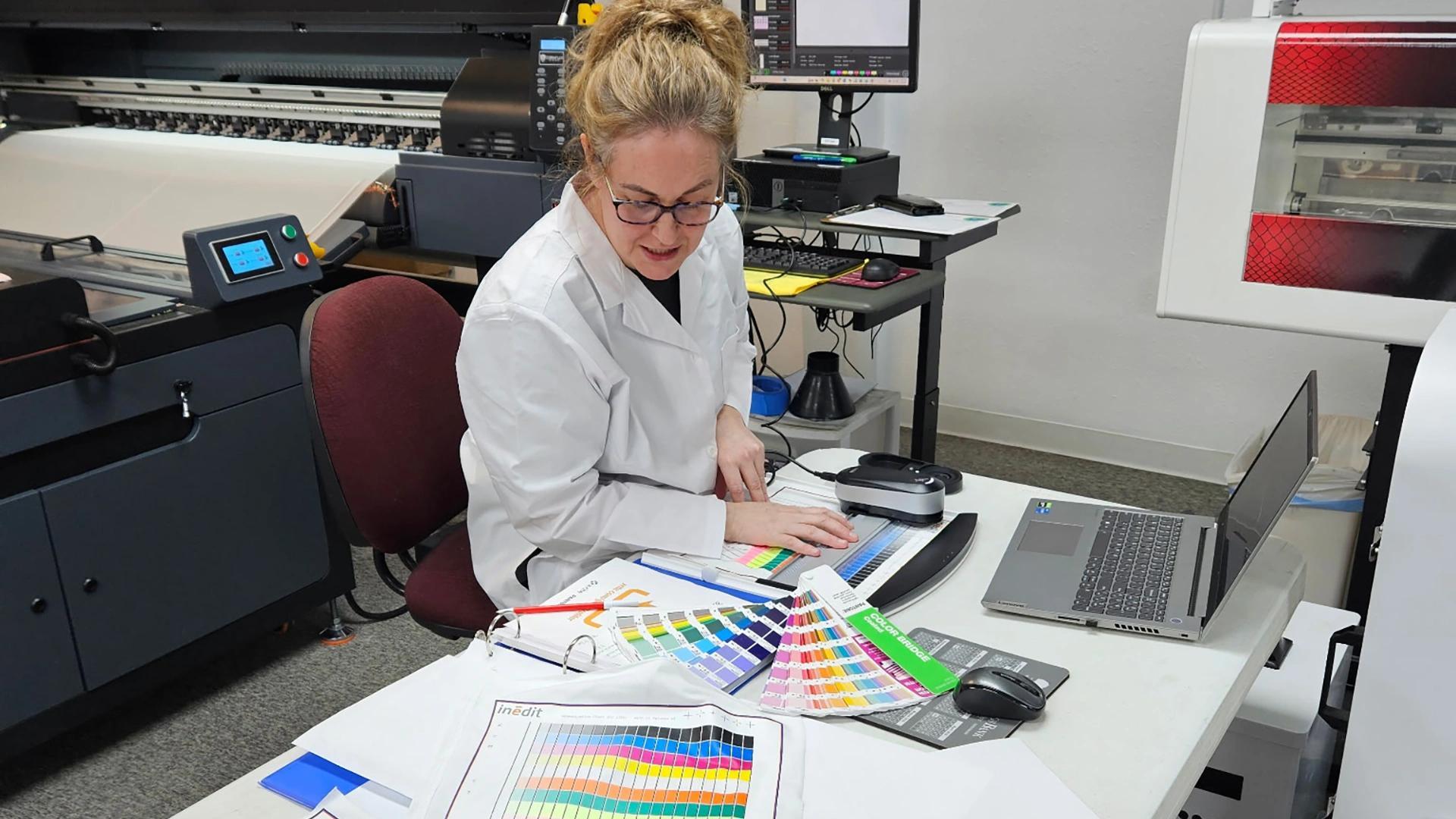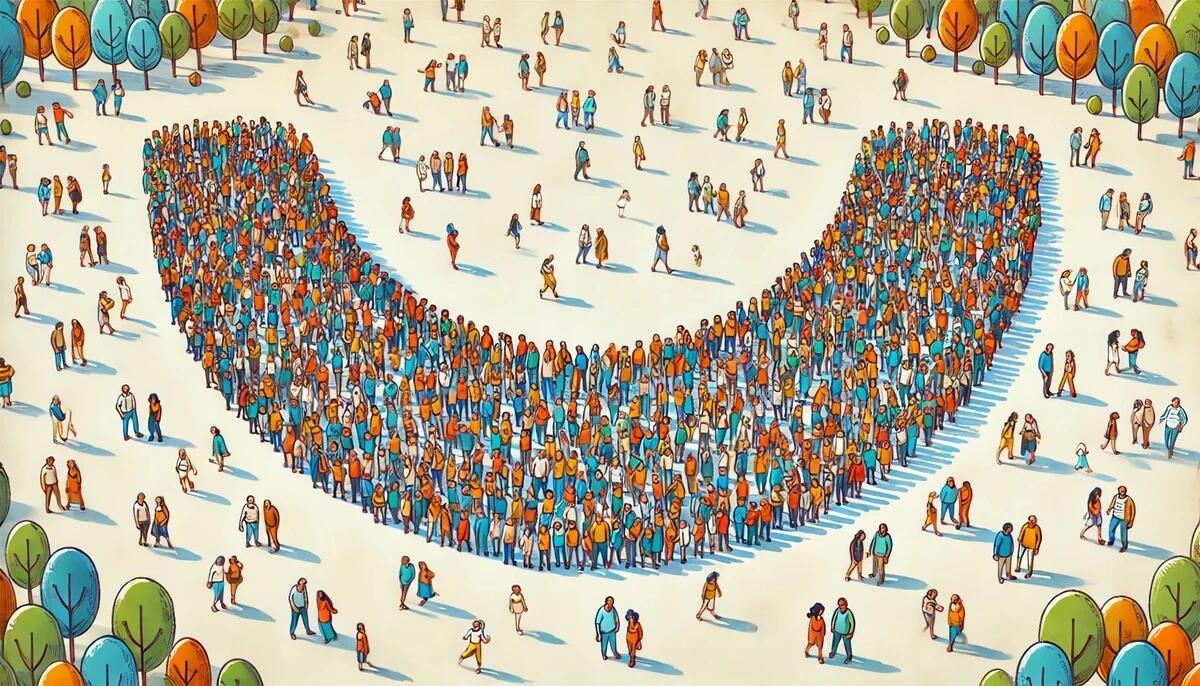Accurate Colors for DTF Transfers
Most DTF providers say they offer “accurate and vibrant colors”—but few can prove it. At DMandprints, we use commercial-grade printers, calibrated with X-Rite spectrophotometers and industry-leading RIP software (NeoStampa), to achieve sub 1 Delta E color accuracy. That means we don’t just claim color precision—we measure it, maintain it, and deliver it consistently, even for the most demanding clients and brands.

Introduction
Color accuracy isn’t a marketing term—it’s a measurable standard. In DTF heat transfer printing, it’s the difference between a shirt that pops and a print that falls flat, or worse, fails to meet brand guidelines. At DMandprints, we’ve built our entire color pipeline around professional-grade calibration and verification.
While most DTF print shops rely on generic CMYK output and call it "close enough," we calibrate our printers using spectrophotometers and maintain ICC profiles with NeoStampa—the same software trusted by the world’s most demanding print manufacturers. We also maintain a custom color book, so our customers get the same result every time, across every run.
If your customers expect brand-level consistency, this article will explain exactly how we deliver it.
Not a Color Nerd? No Problem.
Look—if you're the kind of person who just wants your transfers to look great and don’t need a full seminar on color theory, you can stop reading here and rest easy. We’ve got you covered.
Our customers stick with us because their prints look sharp, vibrant, and most importantly—consistent, order after order.
But if you're curious about how we get there—or if you’ve ever had a print job come back from another provider looking off—you might find the details helpful.
So if you want to geek out with us for a minute and understand why we talk about things like Delta E, ICC profiles, and expanded gamut inks, read on. We’re not trying to make this complicated—we’re showing our work. Because when quality matters, the details matter too.
How We Measure Color Accuracy (and Why It Matters)
Delta E: The Industry Standard for Color Difference
Color accuracy is measured using Delta E (ΔE), which quantifies the difference between a printed color and its intended target. A Delta E below 1 is considered virtually indistinguishable to the human eye under ideal conditions. That’s the level we target—and consistently hit—across our print fleet.
ICC Profile Calibration with X-Rite Spectrophotometers
We use X-Rite spectrophotometers to measure printed color targets and generate calibrated ICC profiles. This ensures your on-screen colors translate to film and fabric as accurately as possible—without muddy reds, washed-out blues, or surprise shifts in brand colors.
NeoStampa RIP: Color Control at Scale
We run all production through NeoStampa by Inedit, the gold standard for RIP software in textile and film printing. It gives us fine-tuned control over color separation, ink limits, and profile management—far beyond what most shops using basic RIPs can achieve.
Beyond CMYK: How We Print More Vibrant Colors with Expanded and Neon Inks
Most DTF printers rely on standard CMYK ink sets, which can only reproduce a limited portion of the visible color spectrum. At DMandprints, we go further.
We run commercial-grade printers outfitted with expanded gamut ink sets—including color expanders and neon inks. These extra channels allow us to reproduce colors that standard CMYK simply can’t reach, especially in the oranges, greens, purples, and fluorescent ranges.
What this means for you:
- More accurate brand colors
- Brighter, punchier neons
- Deeper saturation without losing detail
This expanded gamut makes a huge difference in jobs that require bold graphics, brand consistency, or standout apparel.
Understanding Color Gamut: What You See vs. What Can Be Printed
Screens and printers speak very different languages when it comes to color. Knowing the difference helps set realistic expectations—and helps you understand why our process is designed to bridge that gap as closely as possible.
RGB and LAB: Digital Color Powerhouses
- RGB (Red, Green, Blue) is what your screen uses to display color. It can define over 16.7 million combinations, but many of those are mathematically unique, not visually distinct. The number of visually distinguishable colors is far lower—closer to 200,000 to 500,000 under ideal lighting conditions.
- LAB is a theoretical color space meant to encompass all visible color, including what the human eye can perceive. It defines over 17 million colors, but no printer or screen can reproduce all of them.
Pantone: The Industry Standard for Spot Colors
Pantone defines a specific set of around 1,600 spot colors—used for consistency across industries like fashion, print, and branding. Matching Pantone colors on a DTF printer requires expert color management because Pantone colors don’t always map cleanly to CMYK.
CMYK: The Printing Reality
CMYK printers, even with the best ICC profiles, can typically reproduce 10,000–20,000 colors reliably. With expanders and neons, that number can jump to 50,000+ distinguishable colors—but it still falls short of the total range your screen can display.
That’s why we calibrate everything—using X-Rite devices, custom color books, and Pantone-verified profiles—to make sure we’re getting as close as physically possible to the color you expect.
Color Accuracy is a 50/50 Partnership
We’re proud of what we can deliver—but achieving truly accurate and vibrant color isn’t something any print provider can do alone. If you care about color, it’s a 50/50 partnership:
50% is on us. 50% is on you.
50% is on us. 50% is on you.
1. The Tools You Use Matter
We’re not trying to be rude here—but if you export a low-res, RGB file from the free version of Canva and expect a flawless, 10-inch-wide print with perfect color fidelity… it’s not going to happen. That sets everyone up to fail—no matter who’s doing the printing.
If you're just having fun and making shirts for your friends or an event, no problem—print and press away. But if you're building a brand, creating merch for resale, or doing contract work for clients, your input files need to be created with care.
2. We Can Only Match What You Give Us
If you know what you're doing and you're using the right tools, then we can meet you halfway—and that’s where the magic happens.
In the simplest case, you provide clean vector files (AI or PDF) with defined CMYK values or Pantone swatches.
In more demanding cases, we may go back and forth with sample prints to lock in a specific color match. Once we dial it in, we add that to your custom spot color book—so future orders are always consistent.
In more demanding cases, we may go back and forth with sample prints to lock in a specific color match. Once we dial it in, we add that to your custom spot color book—so future orders are always consistent.
Let’s be honest: achieving sub 1 Delta E color accuracy for brand-level clients isn’t easy. But it’s real work, and it’s worth it. Just like gravity, it’s a reality you have to respect if you want to fly.
Why It All Matters
Whether you're a hobbyist pressing shirts at home or a brand managing thousands of units, one thing is true: color consistency builds trust.
Your customers notice when colors shift—when a logo looks slightly off or a reorder doesn’t match the original. Even if they can’t explain why, they can feel it. That’s the kind of thing that separates a 3-star review from a 5-star referral.
This is why we’ve built DMandprints around precision. From commercial-grade printers and spectrophotometer-calibrated ICC profiles to RIP-controlled color separation and expanded ink sets—every part of our process exists to ensure your colors look right and stay that way.
So don’t settle for “close enough.”
What People Are Saying
FIVE STARS!
"With Dmandprints, I’ve increased my business by over 30%, while saving both time and money. Their quality, service, and attention to detail have been outstanding—highly recommended!"

Essential Tips for Quality DTF Printing
Our guides are perfect for both beginners and seasoned print professionals. Discover valuable tips for creating artwork, mastering heat press techniques, and more. These resources ensure you achieve the best quality final product.
What Makes Dmandprints Different
Loading...
Popular Guides
Loading...
Creating Images for DTFs
Loading...
Feature Articles
Loading...
Q & A
Common Questions
Here are some quick questions and answers we frequently get about DTF prints and DMandPrints. We've placed them right here on the home page for your convenience!
Do you really think you have the best prints in the world?!
Do you really think you have the best prints in the world?!
Mmm... we think they’re pretty great—and we work relentlessly to keep making them better. It’s a bold claim (maybe even a little cocky), so we’ll let the results speak for themselves.
Do you sell printed garments?
Do you sell printed garments?
No, we only sell the prints.
You can purchase your own garment and a heat press to apply the heat transfer prints to your own garments. Our customers are typically small, medium and large screen printers that want to offer heat transfers as an alternative to their standard screen printing process.
Is Gang Sheeting Necessary for Your Artwork?
Is Gang Sheeting Necessary for Your Artwork?
There is no need to gang sheet your artwork.
We charge only for the actual print area. Our image processing system automatically removes any unnecessary transparent space around your image to accurately calculate the print area for our per-square-inch pricing.
Gang sheeting not only costs you time but can also cost you money. We can only trim transparent space around the edges of your artwork. If you create a gang sheet yourself, you might introduce unprinted space that increases the total square inches, leading to higher costs.
Summary
The easiest and most cost-effective way to get your prints is to simply upload your artwork. We'll handle the gang sheeting for you, saving you both time and money.
Are DTF prints better than traditional screen printing?
Are DTF prints better than traditional screen printing?
It's not a matter of being better or worse; DTF (Direct to Film) printing is simply an alternative to traditional screen printing. Both methods have their own unique advantages.
DTF heat transfers feel similar to screen-printed shirts and can often be more durable. Additionally, DTF printing allows for unlimited colors in a single print, providing flexibility for intricate and colorful designs. On the other hand, screen printing is well-loved for its ability to produce vibrant, long-lasting prints, especially in bulk.
Choosing between the two methods depends on your specific needs and preferences.
What types of fabrics can DTF prints be applied to?
What types of fabrics can DTF prints be applied to?
DTF prints can be applied to a variety of fabrics, including cotton, polyester, blends, leather, and even some non-textile materials.
Are DTF prints durable?
Are DTF prints durable?
Yes, DTF prints are known for their durability and can withstand multiple washes without fading or peeling.
Do DTF prints feel heavy or stiff?
Do DTF prints feel heavy or stiff?
No, DTF prints have a soft feel and do not add significant weight or stiffness to the fabric.
Can DTF prints be used for detailed and colorful designs?
Can DTF prints be used for detailed and colorful designs?
Yes, DTF prints are excellent for detailed and colorful designs, providing vibrant and high-resolution results.
Is DTF printing cost-effective for small batches?
Is DTF printing cost-effective for small batches?
Yes, DTF printing is cost-effective for both small and large batches, making it ideal for custom and limited-run designs.
Can I create DTF prints at home?
Can I create DTF prints at home?
While it's possible with the right equipment, most people prefer to use professional services for higher quality and ease of use.